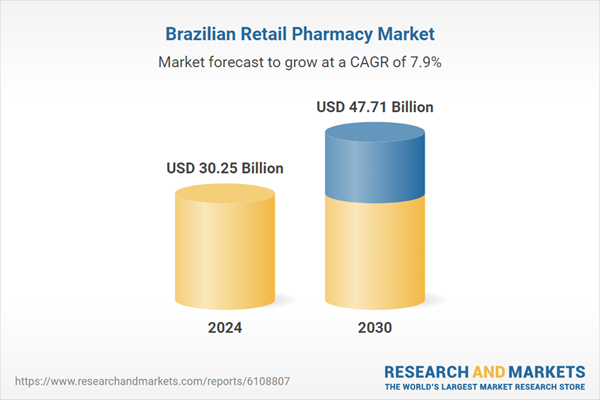Speak directly to the analyst to clarify any post sales queries you may have.
10% Free customizationThis report comes with 10% free customization, enabling you to add data that meets your specific business needs.
The market is undergoing a significant transformation from traditional dispensing models to service-oriented healthcare hubs. Leading chains are increasingly incorporating clinical services such as diagnostic testing, chronic disease management, and vaccination programs, supported by digital platforms and consumer engagement tools. This evolution is enhancing their strategic role in delivering accessible, preventive, and personalized healthcare. As demand for convenience, elderly care, and integrated health services grows, Brazil’s retail pharmacies are set to become key enablers in the nation’s pursuit of decentralized, consumer-centric health delivery.
Key Market Drivers
Aging Population and Chronic Disease Prevalence
The expanding elderly population and the rising incidence of chronic diseases are central to the long-term growth of Brazil’s retail pharmacy sector. By 2050, individuals aged 60 and above are expected to comprise more than 30% of the population, a sharp increase from 14% in 2023. This demographic shift correlates with higher demand for continuous medication regimens, preventive health products, and professional counseling. Older adults often manage multiple conditions, requiring tailored pharmaceutical solutions and adherence support. Retail pharmacies are becoming the preferred healthcare access point for this segment due to their proximity, extended service offerings, and pharmacist-led care. Pharmacies catering to senior needs with personalized services, loyalty programs, and home delivery options are experiencing increased customer retention and higher spending per visit, reinforcing their position in chronic care management.Key Market Challenges
Macroeconomic Instability and Regional Income Disparities
Economic volatility and pronounced regional inequality present key obstacles to market expansion. Fluctuations in Brazil’s GDP, employment, and inflation directly impact consumer healthcare spending, especially for discretionary or out-of-pocket medications. In lower-income regions such as the North and North-East, limited access to private healthcare and constrained purchasing power restrict demand to generics and essential medicines, curbing profitability for retail outlets. These disparities hinder uniform market penetration and create a fragmented landscape. National chains must adjust pricing models, promotional strategies, and product assortments based on regional affordability, adding operational complexity and cost. Additionally, during economic downturns, investment in store expansion and technology upgrades tends to slow, affecting overall market scalability.Key Market Trends
Omnichannel Integration and Digitalization of Pharmacy Services
The rapid shift toward digitalization and omnichannel retail is reshaping Brazil’s retail pharmacy model. Consumers increasingly expect integrated experiences that connect physical stores with online platforms, mobile apps, and home delivery services. Major pharmacy groups are investing in e-commerce, digital prescription uploads, AI-driven customer support, and medication subscription models to enhance convenience and adherence. The integration of telemedicine and virtual consultations is expanding pharmacies’ clinical footprint, positioning them as comprehensive health and wellness centers. This digital pivot also allows pharmacies to extend services into remote areas, boosting accessibility and patient engagement. As digital health tools become more embedded in daily operations, pharmacies that deliver a seamless, tech-enabled customer journey are likely to outperform in customer loyalty and market share.Key Market Players
- Raia Drogasil
- Grupo DPSP
- Pague Menos
- Drogaria Onofre
- Drogaria Pacheco
- Farmácias Guarulhos
Report Scope:
In this report, the Brazil Retail Pharmacy Market has been segmented into the following categories, in addition to the industry trends which have also been detailed below:Brazil Retail Pharmacy Market, By Product:
- Prescription
- OTC
Brazil Retail Pharmacy Market, By Type:
- Chain
- Independent
- Others
Brazil Retail Pharmacy Market, By Region:
- South-East
- North-East
- South
- Central West
- North
Competitive Landscape
Company Profiles: Detailed analysis of the major companies present in the Brazil Retail Pharmacy Market.Available Customizations:
With the given market data, the publisher offers customizations according to a company's specific needs. The following customization options are available for the report.Company Information
- Detailed analysis and profiling of additional market players (up to five).
This product will be delivered within 1-3 business days.
Table of Contents
Companies Mentioned
- Raia Drogasil
- Grupo DPSP
- Pague Menos
- Drogaria Onofre
- Drogaria Pacheco
- Farmácias Guarulhos
Table Information
| Report Attribute | Details |
|---|---|
| No. of Pages | 85 |
| Published | July 2025 |
| Forecast Period | 2024 - 2030 |
| Estimated Market Value ( USD | $ 30.25 Billion |
| Forecasted Market Value ( USD | $ 47.71 Billion |
| Compound Annual Growth Rate | 7.8% |
| Regions Covered | Brazil |
| No. of Companies Mentioned | 6 |









